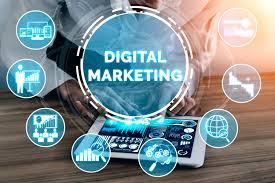Notifications

In the constantly changing landscape of digital marketing, generating high Return on Investment (ROI) is the holy grail of every advertiser. With growing competition and costs of advertising increasing, marketers need to implement more intelligent strategies and tools that guarantee each rupee or dollar spent returns quantifiable value. In 2025, with the further ascendancy of AI, automation, and consumer personalization, maximizing ROI in digital advertising calls for a combination of data-driven insights, creativity, and innovation.
Here's a step-by-step guide to the best practices for maximizing ROI in digital advertising in 2025.
1. Set Clear Goals and KPIs
It is important to set clear goals before running any digital advertising campaign. Do you want to drive website traffic, generate leads, increase sales, or raise brand awareness?
Your business objectives should be matched by key performance indicators (KPIs). For instance:
CTR (Click-Through Rate)
CPC (Cost Per Click)
CPA (Cost Per Acquisition)
ROAS (Return on Ad Spend)
Conversion Rate
By establishing these metrics at the beginning, you can gauge the performance of your campaigns more precisely and make data-driven decisions.
2. Use AI and Machine Learning
AI is the game-changer in 2025. Thanks to machine learning algorithms, advertisers are able to automate ad targeting, bidding, and optimization in real-time.
Advantages of AI in digital marketing:
Predictive analytics for audience behavior
Dynamic content optimization
Intelligent bidding strategies
Improved budget allocation
Google Ads, Facebook Ads, and LinkedIn Ads, for instance, now employ AI to enable advertisers to obtain optimum results with zero manual intervention.
3. Segment and Personalize Your Audience
The one-size-fits-all approach is no longer effective. Employ audience segmentation on the basis of demographics, behavior, location, interests, and purchase history to provide more personalized advertisements.
Better personalization tips:
Employ dynamic content to personalize ads according to user behavior
Retarget users with abandoned carts or browsed product pages
Segment your email and ad campaigns for various buyer personas
Outcome: Improved engagement rates, reduced bounce rates, and improved conversion rates.
4. Spend on High-Converting Creatives
Your ad creative—images, videos, headlines, and copy—can either win or lose your campaign. In 2025, attention is shorter and competition is higher. Spending on high-quality, engaging creatives is a necessity.
Creative best practices:
Make use of short-form videos (less than 15 seconds) with captions
Test several variations (A/B testing)
Emphasize value propositions explicitly
Create a sense of urgency (limited-time promotions, countdown timers)
Such interactive formats as polls, swipe-up, or gamified ads also boost engagement.
5. Prioritize Conversion Rate Optimization (CRO)
Traffic driving is just half the process. You need to convert that traffic to customers. Conversion Rate Optimization (CRO) is the optimization of your landing pages, forms, and user experience to maximize the potential for conversions.
CRO methods involve:
A/B testing landing pages
Optimizing page load speed
Streamlining checkout processes
Employing compelling CTAs (Call-to-Actions)
Each tweak, however slight, can dramatically increase your ROI.
6. Leverage Retargeting and Remarketing
Not all visitors will convert upon their initial exposure to your advertisement. Retargeting allows you to remain top-of-mind by targeting ads to users who have already engaged with your brand.
Successful remarketing tactics:
Prominently display offers for products they've looked at
Provide limited-time promotions for repeat users
Remind users about products in their cart
Google Display Network and Facebook Ads platforms enable retargeting setup to be simple and effective.
7. Analyze and Optimize on a Regular Basis
Campaign optimization is not a once-off activity. Ongoing analysis is important to determine what is working and what isn't.
Important optimization steps:
Check ad performance daily or weekly
Pause poor-performing ads
Scale high-performing campaigns
Adjust budgets by ROI
Continue testing creatives and audiences
Use platforms such as Google Analytics, Meta Ads Manager, and third-party dashboards to consolidate and streamline reporting.
8. Embrace an Omnichannel Strategy
Consumers use multiple channels—web, mobile, social media, search engines, email—in 2025. An omnichannel ad strategy ensures that your message is cohesive across all touchpoints.
Advantages:
Enhanced user experience
Increased brand recall
Increased conversion rates
Ensure your messages, imagery, and promotions are consistent across channels such as Google, Facebook, Instagram, YouTube, LinkedIn, and email campaigns.
9. Employ Smart Budget Distribution
Instead of having fixed budgets, implement dynamic, real-time budget distribution. Spend more on high-performing campaigns and less on low ROI channels.
Tips:
Implement performance-based rules (e.g., automatically increase budget if ROAS > 3x)
Dynamic shifting of budget between platforms
Employ goal setting at the campaign level in Google Ads
This keeps your ad spend focused always on your most successful opportunities.
10. Keep Yourself Informed about Trends and Tools
The digital advertising landscape is constantly changing. To sustain and increase ROI, continue to learn and evolve.
2025's major trends are:
Privacy-first advertising (cookie-less targeting)
AI-powered voice search advertising
AR/VR-based ad experiences
Influencer + paid ads integration
Test and experience new platforms and tools that provide you with a competitive advantage.
Final Thoughts
Improving ROI in digital marketing courses in Chandigarh demands a combination of intelligent technology, creativity, customization, and relentless improvement. As competition grows and consumer behavior changes, companies have to remain dynamic, data-oriented, and customer-focused.


